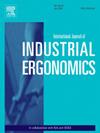A study of upper-body postural parameters for measures of human-seat interaction
IF 3
2区 工程技术
Q2 ENGINEERING, INDUSTRIAL
International Journal of Industrial Ergonomics
Pub Date : 2025-01-01
DOI:10.1016/j.ergon.2024.103683
引用次数: 0
Abstract
This study investigates how five selected upper-body parameters, including Neck Angle (NA), Head Angle (HA), Shoulder Alignment Angle (SAA), Thoracic Kyphosis Angle (TKA), and Sitting Acromial Height (SAH), are related to the measures of human-seat interaction in headrest region, which involve the perceived comfort, contact loading, and muscle activity. Experiments with 25 participants were carried out on a conventional aircraft seat at different conditions to identify and understand the significant upper body parameters that affect the human-seat interaction through cross-correlation analyses. The results show the occupant's initial HA, SAH, and SAA are correlated with multiple human-seat interaction measures for general seating. Among the body parameters investigated, HA appears to be the most influential factor in the seating experience in the upper body region under various sitting conditions. The head movement () with different backrest inclinations is found to be closely associated with the headrest contact loading. This study highlights the dependence of the sitting experience on the characteristics of an individual's natural upper-body position and movement when seated, considering both subjective and objective measures. The findings from this study can be used as anthropometric reference guidelines in seat design and optimization to satisfy more customized demands from the perspective of the individual's body characteristics.
测量人体与座椅相互作用的上半身姿势参数研究
本研究探讨了颈角(NA)、头角(HA)、肩对角(SAA)、胸后凸角(TKA)和肩峰高度(SAH)这五个选定的上肢参数与头枕区域人座互动测量的关系,包括感知舒适度、接触负荷和肌肉活动。在常规飞机座椅上进行了不同条件下25名参与者的实验,通过相互关联分析来识别和了解影响人座交互作用的重要上半身参数。结果表明,乘员的初始HA、SAH和SAA与一般座位的多种人座交互措施相关。在所调查的身体参数中,HA似乎是在各种坐姿条件下上半身区域座位体验影响最大的因素。研究发现,不同靠背倾斜度的头部运动(ΔHA)与头枕接触载荷密切相关。这项研究强调,考虑到主观和客观的测量,坐姿体验对个人自然上半身位置和坐姿运动特征的依赖性。本研究结果可作为座椅设计和优化的人体测量学参考指南,从个体身体特征的角度满足更多的定制需求。
本文章由计算机程序翻译,如有差异,请以英文原文为准。
求助全文
约1分钟内获得全文
求助全文
来源期刊
CiteScore
6.40
自引率
12.90%
发文量
110
审稿时长
56 days
期刊介绍:
The journal publishes original contributions that add to our understanding of the role of humans in today systems and the interactions thereof with various system components. The journal typically covers the following areas: industrial and occupational ergonomics, design of systems, tools and equipment, human performance measurement and modeling, human productivity, humans in technologically complex systems, and safety. The focus of the articles includes basic theoretical advances, applications, case studies, new methodologies and procedures; and empirical studies.

 求助内容:
求助内容: 应助结果提醒方式:
应助结果提醒方式:


